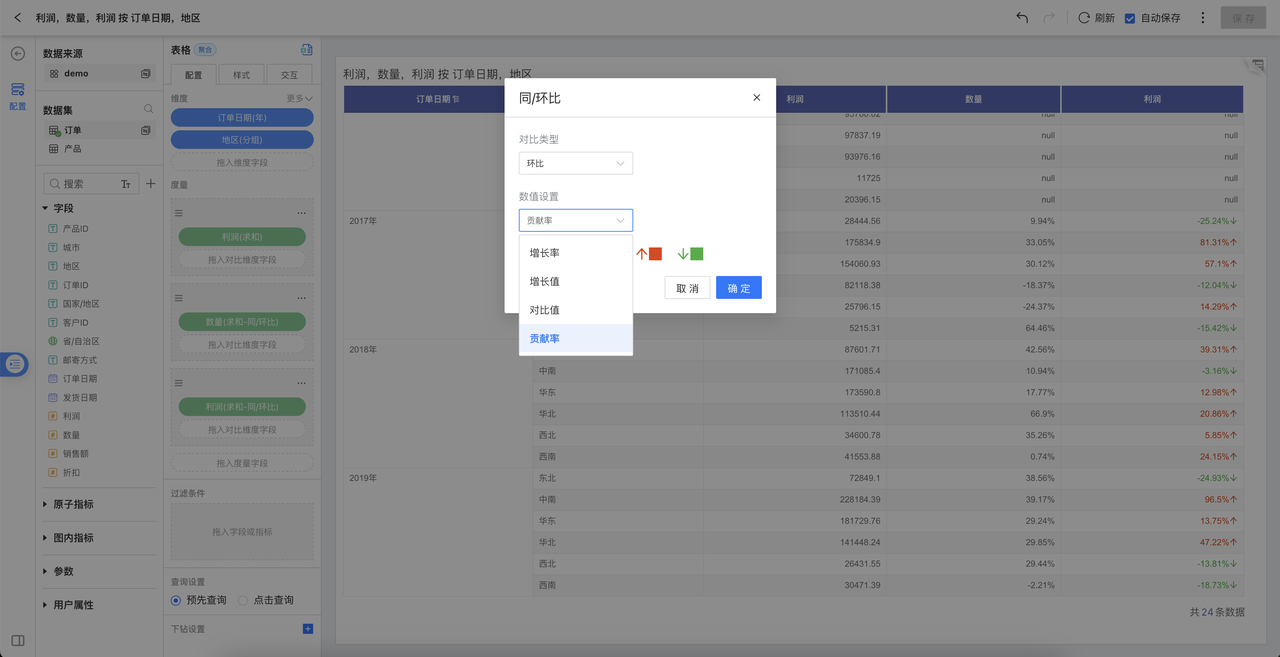Year-over-Year and Month-over-Month Comparison
The minimum aggregation level supported for year-over-year and month-over-year calculations is "day," and the maximum is "year." The menu location for year-over-year and month-over-year comparison is as shown in the figure:
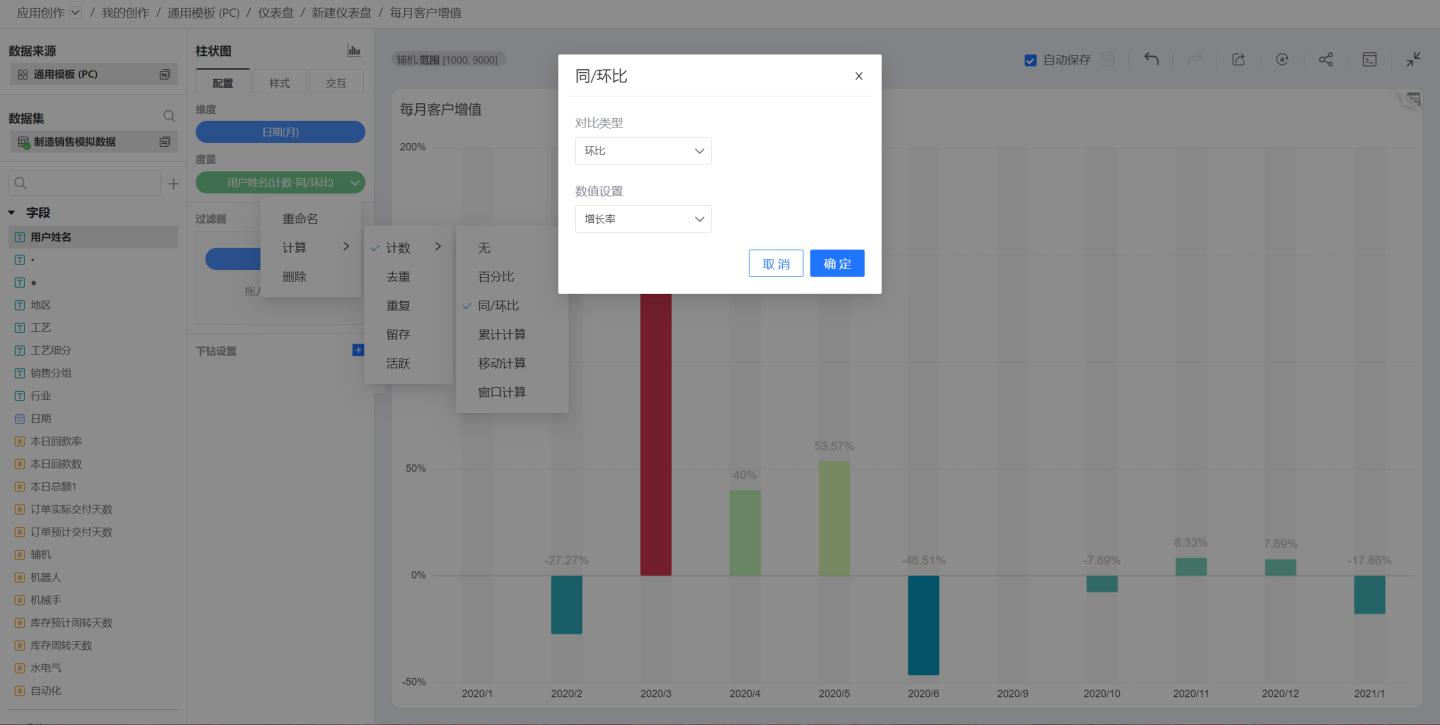
Year-over-year and month-over-year comparison not only supports the previous period comparison but also supports specifying relative dates, as shown in the figure below: 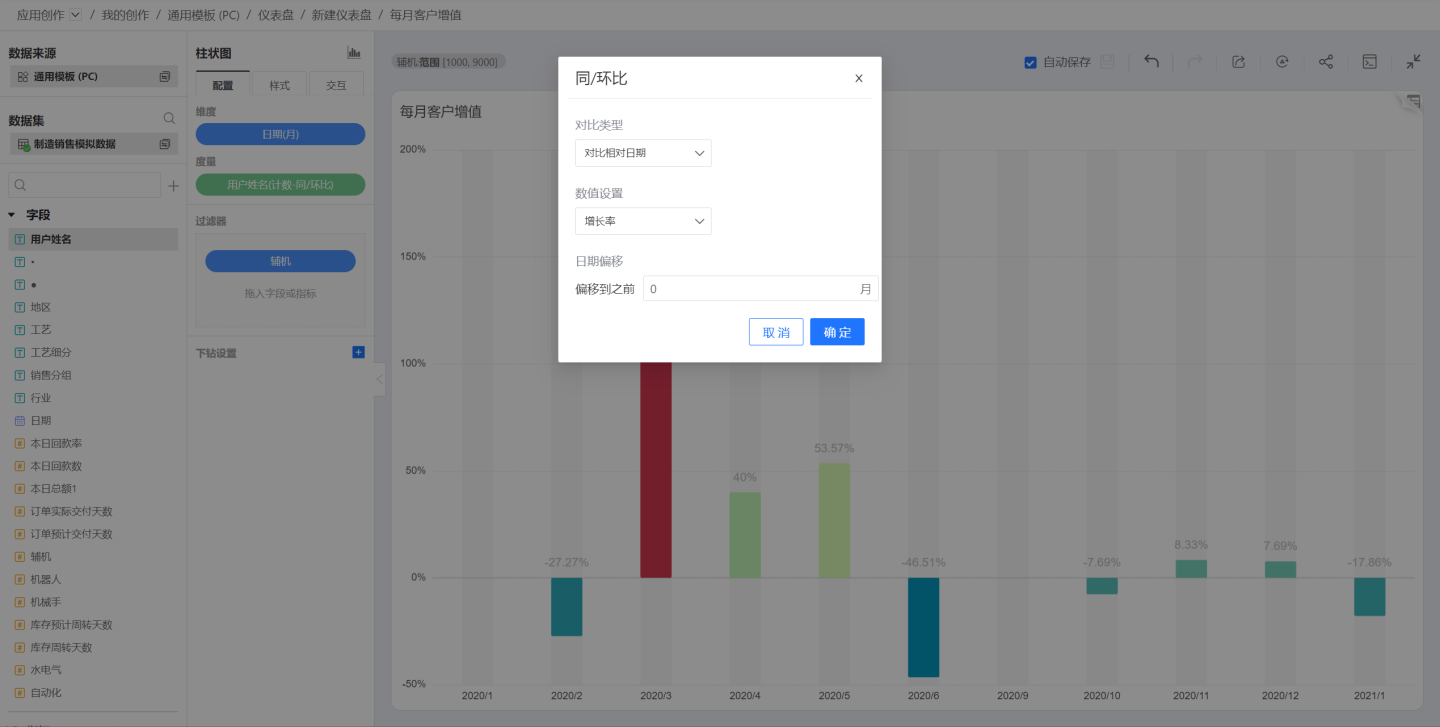
The year-over-year and month-over-year comparison in tables supports "trend indication," as shown in the figure below. When calculating year-over-year and month-over-year, after checking "trend indication," the displayed trend indication: 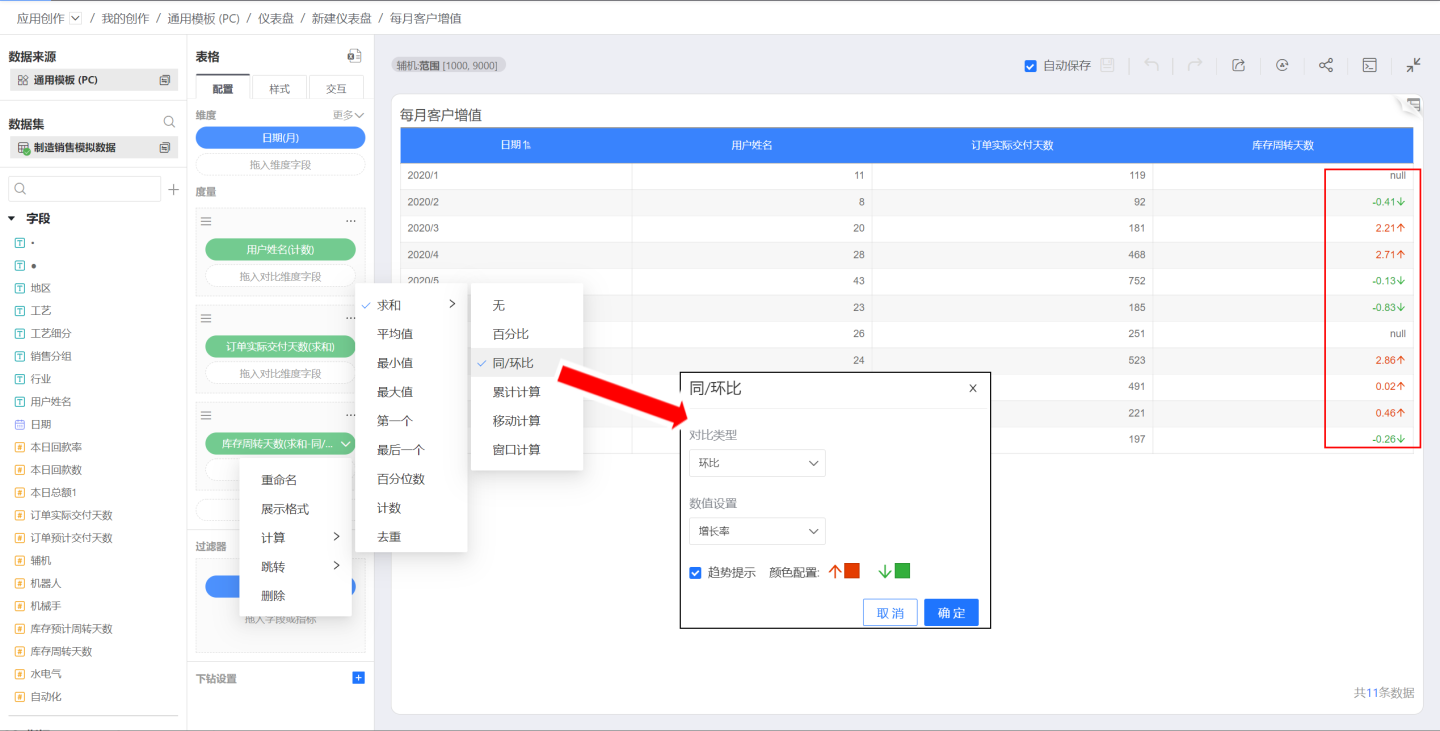
Time Dimension YoY and MoM Interaction
When switching the aggregation unit of the time dimension (day, week, month, quarter, year), the content of the "Comparison Type" dropdown list will automatically adjust:
| Time Dimension Aggregation | MoM | Week | Month | Year | Comparison Relative Date |
|---|---|---|---|---|---|
| By Day | MoM | Same Period Last Week | Same Period Last Month | Same Period Last Year | Previous N Days |
| By Week | MoM | - | - | Same Period Last Year | Previous N Weeks |
| By Month | MoM | - | - | Same Period Last Year | Previous N Months |
| By Quarter | MoM | - | - | Same Period Last Year | Previous N Quarters |
| By Year | MoM | - | - | - | Previous N Years |
When switching the aggregation unit of the time dimension (day, week, month, quarter, year), the selected content in the "Comparison Type" will be adjusted accordingly and recalculated. When switching the time dimension aggregation unit, if the same type cannot be found in the "Comparison Type" dropdown list, the advanced calculation will be canceled and changed to "None". For example, if the time dimension was previously aggregated by day and we selected "Same Period Last Week", and then we switch the time dimension to aggregate by week, we cannot find the "Same Period Last Week" comparison type, so the advanced calculation should be canceled and changed to "None".
Compare to Previous Period
In the Chinese context, year-on-year (YoY), quarter-on-quarter (QoQ), and month-on-month (MoM) comparisons traditionally refer to comparisons based on natural months, natural quarters, and natural years. For example, generally speaking, the year-on-year sales growth from 2024/06/01 to 2024/06/18 refers to the growth compared to the same period in the previous year, i.e., from 2023/06/01 to 2023/06/18, while the month-on-month growth refers to the growth compared to the period from 2024/05/01 to 2024/05/18. Sometimes we want to compare with a previous continuous period based on a specified step length. For example, the period from 2023/06/01 to 2023/06/18 has 18 days, and we want to compare it with its immediately preceding 18 days, i.e., from 2023/06/13 to 2023/06/30, to observe the immediate status of the 618 promotion. In this case, we can use the Compare to Previous Period function in the same period comparison. 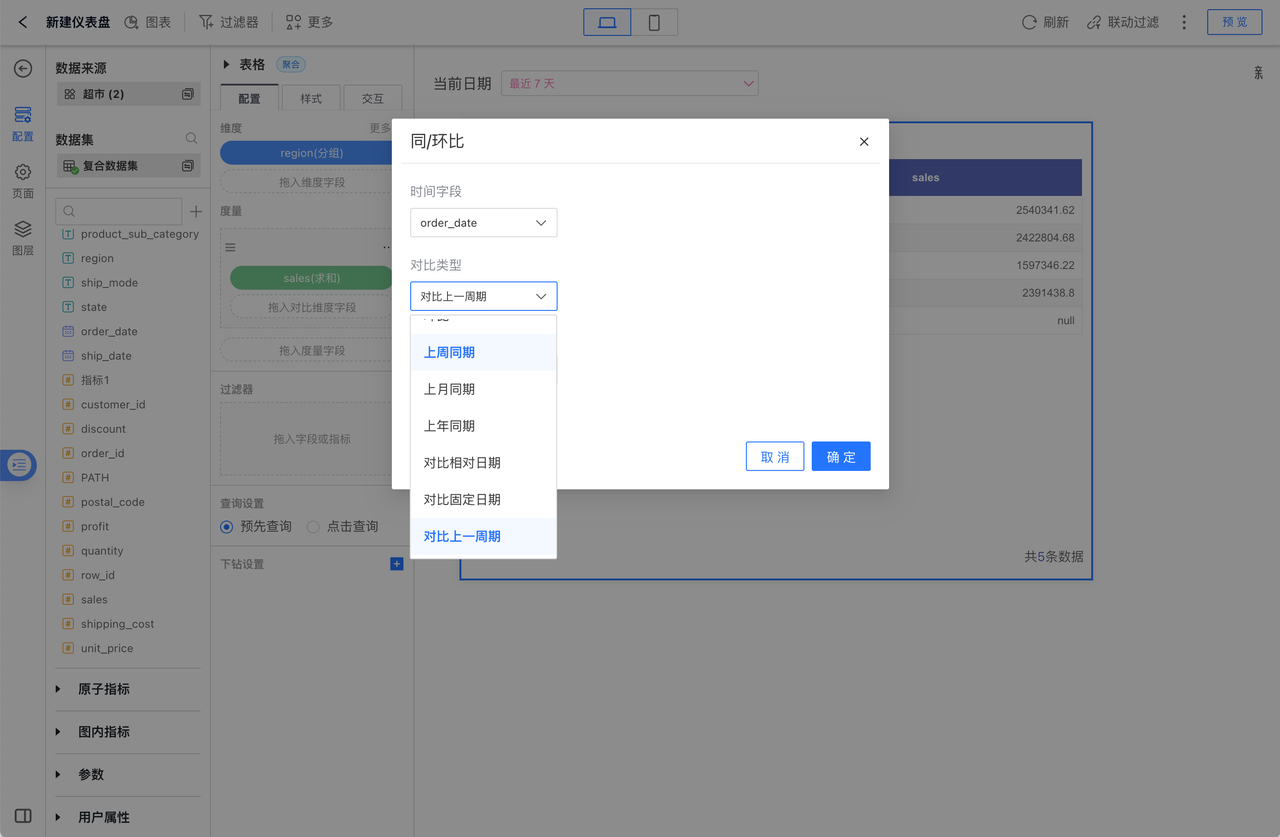
Non-Time Dimension YoY and MoM Interaction
Different time dimension aggregation units correspond to the following "comparison types":
| Time Dimension Aggregation Unit | MoM | Same Period Last Week | Same Period Last Month | Same Period Last Year | Relative Date | Fixed Date |
|---|---|---|---|---|---|---|
| By Day | MoM | Same Period Last Week | Same Period Last Month | Same Period Last Year | Today/Yesterday/Previous N Days, compared to previous M days | Specific days, compared to specific days |
| By Week | MoM | - | - | Same Period Last Year | This Week/Last Week/Previous N Weeks, compared to previous M weeks | |
| By Month | MoM | - | - | Same Period Last Year | This Month/Last Month/Previous N Months, compared to previous M months | |
| By Quarter | MoM | - | - | Same Period Last Year | This Quarter/Last Quarter/Previous N Quarters, compared to previous M quarters | |
| By Year | MoM | - | - | - | This Year/Last Year/Previous N Years, compared to previous M years |
When switching the time dimension aggregation unit (day, week, month, quarter, year), if there is a corresponding option, switch to it (for example, when comparing relative dates, if aggregated by day, yesterday compared to the previous 3 days, when switching to weekly aggregation, it can become last week compared to the previous 3 weeks). If there is no corresponding option, directly switch to "MoM".
Metric Contribution Rate
The contribution rate reflects which dimension values are the more critical influencing factors in the changes of a metric. The contribution rate can be used in conjunction with or independently of most year-over-year and month-over-month comparisons. The contribution rate of a metric is only meaningful in the context of year-over-year or month-over-month comparisons. The algorithm for the contribution rate is as follows:
Metric Growth Value = Current Metric Value - Comparison Metric Value
Metric Contribution Rate = Metric Growth Value (in specific dimension values) / Metric Growth Value (overall)An intuitive understanding can be as follows: for example, if the dimension is category and the metric is sales, then the contribution rate of sales in the "Furniture" category is: the growth value of sales in the Furniture category as a proportion of the growth value of sales in all categories. It can intuitively measure which categories are driving the growth in sales.
